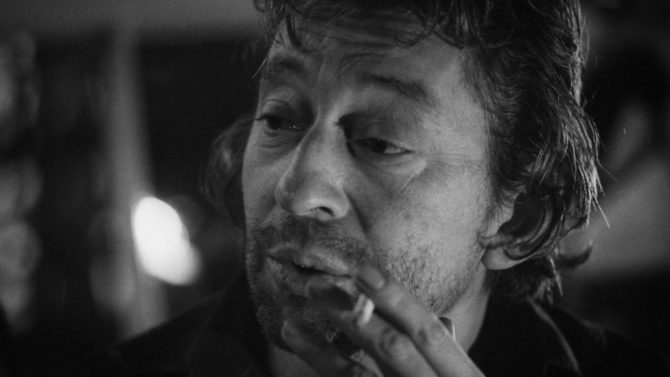A French icon: the life of Serge Gainsbourg

French singer and songwriter Serge Gainsbourg revelled in his ability to shock people with his lyrics and lifestyle and arguably affected French popular culture more than any other artist of the 20th century

Serge Gainsbourg brought a whole new meaning to the word ‘dishevelled’. There he was, cigarette firmly clasped to his lips, five o’clock shadow permanently playing around his sallow skin, wine glass in hand and bags under the eyes that made him look like a particularly lecherous frog. He didn’t look capable of anything much.
Yet Gainsbourg – who was born Lucien Ginsburg on 2 April 1928 in Paris – was one of France’s most original, multi-faceted and popular artists. Singer, songwriter, pianist, painter, poet, screenwriter, actor and director, Gainsbourg had his artistic fingers in endless pies and arguably affected French popular culture more than any other artist of the 20th century.
But it wasn’t just his undeniable artistic talents that made Gainsbourg such a star; it was also his character. Unrepentantly provocative from the start, he melded a fierce intellect and a clear suspicion of authority to produce controversial lyrics and uncomfortable personal appearances. One of his first recorded successes was 1958’s Le Poinçonneur des Lilas, a song that described the humanity-sapping work of a Paris métro worker who spent all day punching holes in endless tickets. The song ends with the main character fantasising about punching a hole in his own head – with a bullet.
_________________________________________________________

Don’t miss
Quiz: Can you name these famous French icons
_________________________________________________________

A distrust, or perhaps even hatred, of those in power surely wasn’t all that surprising. Gainsbourg was the son of Jewish Ukrainian immigrants who fled to Paris after the 1917 Russian Revolution, only to find themselves in the eye of the storm once more when Germany occupied France during World War II. The Ginsburg family left the capital for Limoges in the so-called ‘zone libre’, travelling with false papers. But the trauma of being Jewish at that time affected Gainsbourg deeply. He heard many stories of persecution while teaching music and art near Paris in a school that was set up for the orphaned children of murdered Jews.
Gainsbourg’s public career didn’t really take off until he was 30 years old, but prior to his first success he had already been trying to make it, first as a painter, then as a pianist in bars. Despite looks that could most kindly be described as ‘interesting’, Gainsbourg’s first marriage to the painter Lise Levitsky in 1951 fizzled out six years later amid rumours of numerous infidelities on his part.
The singer Michèle Arnaud first noticed his musical talent when he was her pianist and Gainsbourg was soon providing material for stars including Juliette Gréco, Petula Clark and Françoise Hardy. He penned Poupée de Cire, Poupée de Son for France Gall, who won the 1965 Eurovision Song Contest with the tune, representing Luxembourg at the age of just 17.
A year later, Les Sucettes, again sung by Gall, caused outrage with its none-too-subtle double entendres. Gall claims she had innocently recorded a song about lollypops, but many interpreted the lyrics as discussing sexual activity. Gainsbourg clearly enjoyed the controversy and songs about sex, both suggestive and explicit, became linked with the singer’s work. He recorded Je T’Aime… Moi Non Plus with French sex symbol and actress Brigitte Bardot in 1967. The pair were having a brief affair at the time, but Bardot begged him not to release the song. Gainsbourg’s next girlfriend, English actress Jane Birkin, had no such qualms, and a version with Birkin groaning in sexual ecstasy became a worldwide smash in 1969, although it was banned by the BBC. Birkin said that Gainsbourg played the track in a Paris restaurant immediately after they had recorded the song, “and as it began to play all you could hear were the knives and forks being put down.” “I think we have a hit record,” said Gainsbourg.
Over the next 11 years before their split in 1980, Gainsbourg and Birkin became one of France’s most famous couples, though this didn’t necessarily help Gainsbourg’s musical career. His reputation for being difficult and headstrong meant that radio stations were reluctant to play his records. After suffering a heart attack in May 1973 Gainsbourg gave an interview from his hospital bed where he announced that he was going to deal with this serious health problem “by upping my intake of booze and ciggies.” No one doubted that he meant it.
The 1970s also saw Gainsbourg appearing in numerous poor films addressing controversial themes including incest and exhibitionism. But it was again with music, a 1979 reggae version of French national anthem La Marseillaise, that he came to the fore again. Many viewed his version as disrespectful, and French paratroopers turned up at a concert in Strasbourg, forcing its cancellation amid fears that a bomb had been planted in the venue.
_________________________________________________________
Don’t miss
A French icon: the Citroën 2CV
_________________________________________________________
In the next decade, Gainsbourg’s artistic output declined and he became something of a caricature, with his frequently drunken TV appearances seemingly designed to shock people. The most notorious incident came after a 1986 appearance on a mainstream Saturday night talk show alongside Whitney Houston, when Gainsbourg openly admitted – in English – that he wanted to have sex with the American singing star.
Gainsbourg died in Paris on 2 March 1991 at the age of 62 after suffering a fifth heart attack. He had just finished preparing a blues album to be recorded in New Orleans. His unique personality and clear aversion to following convention made him an icon of French counter-culture. But while a lack of focus meant his output was uneven, there is no denying that the artist’s best work and formidable personality make him one of France’s most revered artists.
Like this? You might enjoy:
Share to: Facebook Twitter LinkedIn Email
More in french icon


